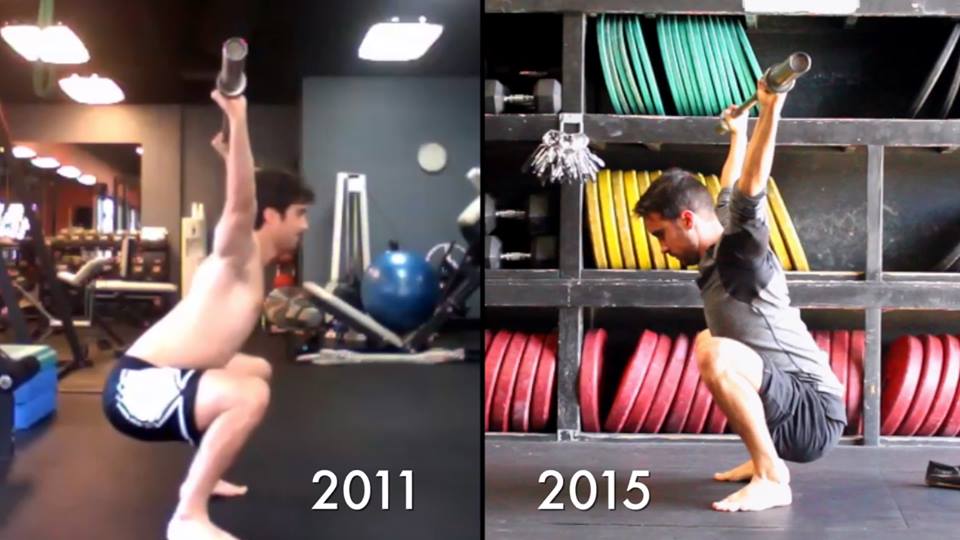The Ultimate Guide to Shoulder Impingement for Weightlifters
Weightlifting is badass. Its good for your health and it makes you feel good.
But what happens when you start getting pain or impingement feelings when you try to snatch, overhead squat or press weights overhead?
Watch the video above or read more below to find out!
What Is Shoulder Impingement?
Shoulder impingement occurs when the tendon of the supraspinatus muscle gets pinched in the upper shoulder. The cause of shoulder impingement is (basically):
- crappy upper body posture and
- key muscles that are too dense or tight.
Of course bony anatomy (acromion type), etc can have an influence – but you don't have any direct control over that and surgeries to fix such issues are risky and expensive.
Your best bet is to fix your posture (office dwellers go here) by doing tissue work, stretching and strengthening exercises and learning to move better.
But why do you get impinged in the first place?
Anatomy

The supraspinatus is the top muscle of your rotator cuff. It connects the scapula to the humerus. The tendon runs through a small area under your acromion process. This cramped little space is where the tendon becomes impinged and is the reason why you can't overhead press anymore.
What Influences Shoulder Impingement?
The video above addresses the top 3 factors that influence shoulder impingement.
Here are some more influences:
- Tissue Quality – Years of poor posture make muscles dense and fibrous (think beef jerky.) Previous injuries (scar tissue) and daily wear-and-tear add up to dense, junky tissue.
- Muscle Extensibility – How many minutes a day do you spend with your arms overhead? Less than 1? So what makes you think you can go from no preparation to ballistically snatching and pressing heavy weights overhead with no consequences? Learn to stretch!
- Thoracic Spine Mobility – This is a biggie. Watch the video for how to fix your stif t-spine.
- Degree of Elevation – the more you raise your arm overhead, the greater the degree of impingement. This is why I typically modify an athletes training (in the short term) to include less overhead pressing movements.
- Acromion Type (I, II or III) – Yes, bone shapes matter. Unfortunately you have no control over this part.
- Rotator Cuff Stability – How well does your rotator cuff dynamically stabilize the joint in various angles and under various loads?
- Scapular Stability & Mobility– the more stable and mobile the scapula, the more likely it is to be in a proper position when you need it. This requires "taking the breaks off" (releasing the pecs, for example) as well as training proper scapulohumeral rhythm via practice.
- Humeral External Rotation – Certain movements that lock the humeral head in internal rotation (think bench press) increase the degree of impingement this is why I have most impingement athletes do dumbbell bench presses with a neutral grip rather than bench press.
- Breathing Patterns – be a "belly breather" rather than "chest breather."
- Lower Body Mobility Issues– Tight hips and ankles downstream can increase shoulder impingement in the overhead squat upstream.
What Can You Do?
If the internal rotators of the shoulder (pec major, subscap and lats) are too strong, and the rotator cuff and the scapular retractor (rhomboids, lower trap) muscles are to weak – impingement can occur.
More specifically, I've found in most people that it is not purely a strength/weakness imbalance. Rather, it is a postural problem. When the posture is corrected and muscles that are overly dense/tight are relaxed and lengthened – strength and balance are restored automatically.
This phenomenon of muscles being too weak to do their job is referred to as positional inhibition. Fixing it is how you fix shoulder impingement.
It is also important that you learn proper technique (core bracing, cervical positioning, etc) and a few anatomical principles (plane of scaption / using a slight shoulder exernal rotation force to unimpinge yourself) – but these are complex topics that I cover more in-depth in my Super Shoulders program.
If you want a 30-day program to fix shoulder impingement – click below:
About The Author

Shane Dowd is a sports performance and mobility coach. He specializes in injury prevention and flexibility for athletes.










